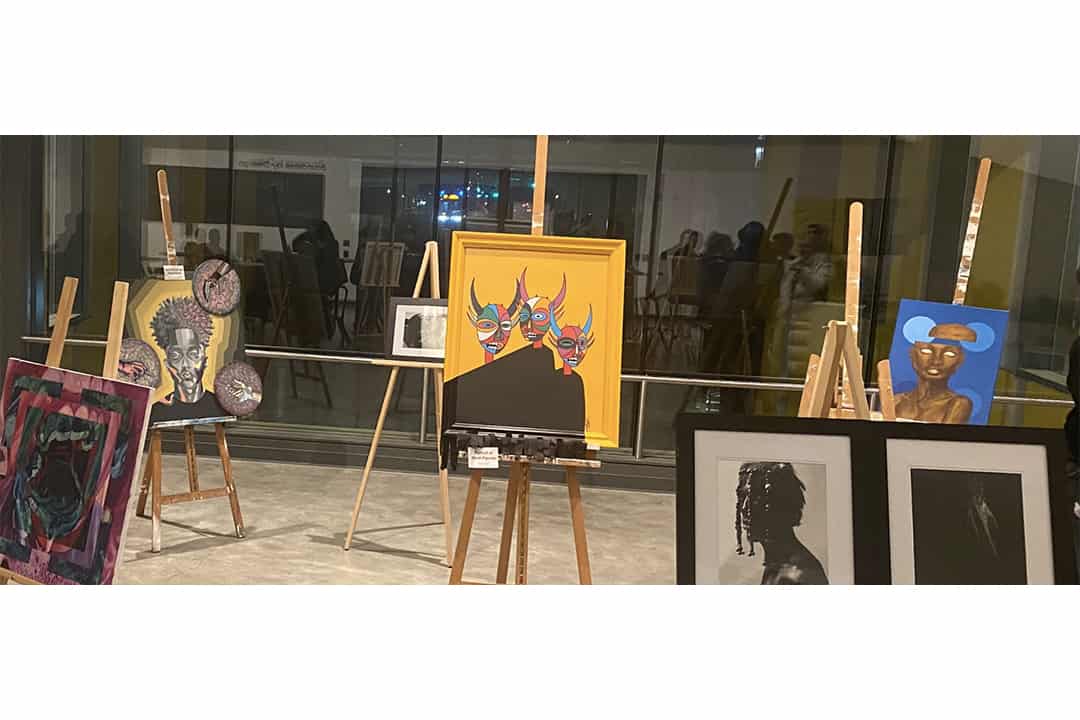On the evening of January 26, U of T’s Black Student Association (BSA) hosted an art show at the Daniels Building in collaboration with OCAD University’s Almeda Black Student Collective. The art showcase — Revival —featured work from U of T and OCAD students and demonstrated the abundance of talent at both universities. Highlighting the work of Black artists, the show featured an array of artistic mediums, including painting, sculpture, photography, and everything in between.
Hosted in the main entry hall of the Daniels Building, the showcase had a welcoming atmosphere, inviting both artists and spectators to mingle and connect throughout the night. Connection was a prevalent theme at the show, both on and off the canvas, as much of the artwork explored motifs of community and identity.
In an interview with The Varsity, Irene Olayinka, an equity officer for the BSA, noted that the artists’ mere willingness to come out and share such personal work is “very telling”: “If you want to have meaningful community, you must be vulnerable in some way.”
“Providing a space for vulnerability has been really conducive to creating this community [for artists],” she added.
Vulnerability and introspection seem to have been pouring from the brushes of many of the event’s painters. One artist who showcased their work, Zenzele Shange, presented a self-reflection portrait composed over four years, representing the struggles the artist experienced with identity throughout the COVID-19 pandemic.
Chimemelie Okafor presented their piece “Posterity,” which is equally as vulnerable and identity-focused but takes a different approach to the theme. “Posterity” is a unique adaptation of Nigeria’s coat of arms featuring the artist’s face. According to Okafor, their painting nods to their perspective on Nigeria’s ongoing political and economic crises and serves as a call to action to protect future generations through changemaking.
The variety of artists’ depictions of their identities was fascinating. Some artists, like Shange, portrayed themselves through periods of profound personal struggle, change, and growth, while others, like Okafor, addressed their personal stakes in political issues.
According to Olayinka, one thing that the artists at Revival shared was a collective struggle for recognition in the art sphere. “Black artists are often overlooked, underrepresented, and not properly acknowledged,” she said. The issue of distinguishing Black artists and their work within the broader art community was a topic of major interest in my discussions with Revival’s organizers.
Regarding Black students’ participation in art, Olayinka made the point that being a Black student in a predominantly white institution means that your work is “filtered through the lens of ‘you’re doing an activity, but you’re a Black person doing that activity.’”
Vanessa Mutai, the BSA’s vice-president internal, agreed with Olayinka, remarking that “often when Black artists engage with art, they’re put into the box of being a Black artist first.”
Mutai pointed out a series of portraits by AY Johnson as an example: “I think in any other space you would be focused on [the subjects’] Blackness above anything else, rather than seeing them as portraits.” The series Mutai referred to, by Johnson, is titled “Itumọ.” Itumọ means “translation” in Yoruba, reflecting the artist’s intention of representing Yoruba mythologies and heritage through her eyes. The subjects include AY’s brother and friend.
Mutai’s comment highlights the danger of exclusion when considering Black art solely through a racial lens and differentiating between the labels of ‘Black art’ versus ‘art.’ At Revival, Johnson’s portraits were given the chance to be appreciated as nuanced portraits rather than only as portraits of Black bodies.
In their work, the artists at Revival did not focus solely on what it means to be Black. Femininity, for example, was the key theme in Eira McIntosh’s “Florid.” McIntosh collected materials for the piece over a long period of time, and the result is a crafted necklace with a large scavenged skull as its pendant. The piece is meant to question preconceived ideals of femininity, contrasting ornateness and darkness.
Mozelle Ofori-Atta, an architecture student at U of T, created the installations “Mylar Façade” and “Density.” She brought together her passions for visual art and architecture to exhibit these pieces, which she originally submitted as assignments for her architecture program. She made “Density” using 3D printing, and “Mylar Façade” by using laser cutting techniques on mylar sheets.
When asked about the overall goal of Revival, Oyindamola Dina, one of the BSA’s education and outreach directors, explained, “We like to showcase the different aspects of Black culture from different continents, countries, ethnicities, and all across the diaspora.”
By this measure, Revival was immensely successful — it saw pieces inspired by various cultures, themes, and interests. Through their participation in the showcase, artists had the opportunity to share the stories behind their work, gain recognition among their peers, and build a community centred on their art and the experiences that influence it.



No comments to display.